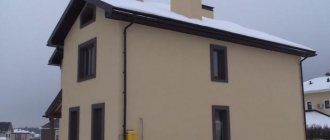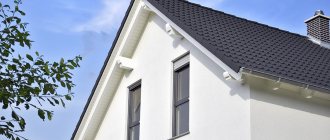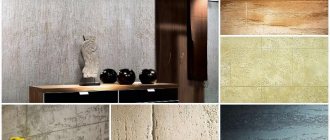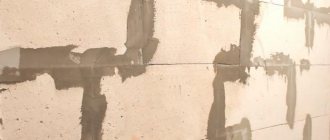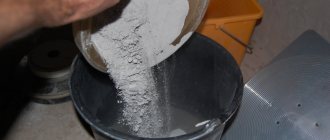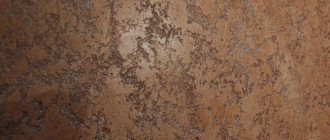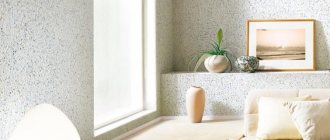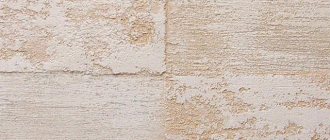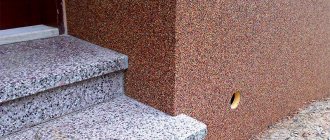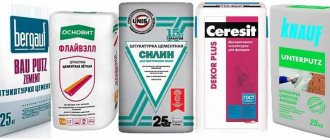Barite plaster is a protective coating for walls, floors and ceilings that attenuates ionizing radiation from radionuclides. It is used for finishing the walls of medical offices, laboratories and other rooms with X-ray equipment.
In addition to plaster mixtures, there are other materials containing barite: floor screed and plasterboard sheets. In this article we will analyze in detail the design of X-ray protective plaster and application technology.
X-ray room
Composition and features of use
The walls, floors and ceilings of X-ray rooms should be covered with radiation-resistant material to protect other areas from the outside. Using lead sheets for this is expensive and ineffective, so shielding barite plaster is used.
It consists of:
- cement, which is used as a binding component;
- barite concentrate (GOST 4682-84);
- polymer additives that increase plasticity, protective properties of the composition and adhesion.
Manufacturers of ready-made mixtures: Fullmix, Sorel Barit M150, Runit, Rosi, Alfapol SHT-Barit.
The thickness of barite plaster in a room with radio radiation depends on the power of the device (for example, on the voltage on the X-ray tube) and in each case is calculated individually according to SanPiN 2.6.1.1192-03 ().
Specifications
Let's consider the main technical indicators of barite plaster using the example of “Full Mix”.
| Color | grey |
| Binder | cement |
| Minimum layer thickness | 5 mm |
| Thickness of one layer no more | up to 10 mm |
| Consumption of dry mixture per 1 m2 with a layer thickness of 10 mm | 21 kg |
| Water consumption per 1 kg of dry mixture | 0.21–0.25 l/kg |
| Water holding capacity | no more than 90% |
| Density (volumetric weight) of the mixed solution | 2700 kg/m3 |
| Time to use finished plaster | no more than 2 hours |
| Compressive strength of the mortar after 7 days | 17 MPa (170/kg/cm3) |
| Radiation safety standard (NRB-99) | 1 class |
| Drying time (depending on layer thickness) | 8 hours |
| Non-flammable material, GOST 30244-94 | NG |
| Specific effective activity of radionuclides | no more than 370 Bkg/kg |
| Use temperature | from +5 to +35 |
Lead equivalent
In order to correctly calculate the required thickness of the plaster layer, you should take into account the maximum power of the X-ray equipment that will be installed in the room, and the design documentation, which indicates the standards for the thickness of lead protection. The latest figures can be used for recalculation.
Lead equivalent (mm Pb) shows what thickness of lead the plaster layer corresponds to for a given amount of ionizing radiation.
For example, to finish a room where, according to the project, lead sheets should have a thickness of 1.47 mm, a 10 mm layer of Sorel M150 plaster will be required. To make a layer of the required thickness, you will need 15 kg of dry mixture.
Important! The concentration of barite in different compositions varies, and the effectiveness of the protective properties of the plaster should be confirmed by a sample test report and a certificate of conformity, such as these.
The test report contains a table with lead equivalent. For example, she looks like this.
Plastering technology
The installation of X-ray protective barite plaster is regulated in the standard technological map ().
Chain-link mesh for reinforcement
Before applying the solution, the surfaces are prepared: they are cleaned of old finishes, cracks are sealed, and they are coated with a non-alkaline-based primer . It is better to prime the walls in 2 layers, because a heavy solution requires good adhesion.
Install the reinforcing mesh. Drill holes for dowels over the entire surface and fix the mesh using self-tapping screws.
Barite plaster is applied to walls in the same way as ordinary cement-sand plaster. If they are aligned using beacons from the solution, then they work in this order:
- Markings are carried out on the prepared walls using a building level: vertical lines are drawn at equal distances.
- I throw the solution onto the mesh and level it using the rule. The thickness will correspond to the height of the beacons.
Moisten the marked areas with a spray bottle of clean water.
- Throw barite solution along the line from bottom to top. The width of the strip should be about 5-7 cm.
- Level the thickness of the layer - it should be the same along the entire length of the line.
- Using this technology, they make 2 beacons at different ends of the wall.
- Stretch the ropes at the top, bottom and center of the finished beacons, and use this marking to create the rest.
After the solution has hardened, apply plaster to the wall. The surface is leveled with a rule, leading it from below to the ceiling.
Important details:
- Due to the high density of the solution, barite plaster is recommended to be applied at a time in a layer of up to 10-12mm. If the planned thickness is more than 30 mm, then a reinforcing mesh must be used. The composition must set, so at least 8 hours must pass between applications.
- Each layer must be primed.
- To protect against cracking, the fresh finish is covered with film and protected from drafts for 7 days.
Expert opinion
Sergei Shablovsky
Plasterer
Wiring and other communications in the room are laid before plastering. It is impossible to scratch the coating: the thickness of the protective layer decreases, which is why the protective properties are reduced.
Since barite plaster serves to protect people from radiation, you should strictly adhere to the work technology when applying it, purchase only proven compositions with proven effectiveness, and not perform work without proper training and experience.
We hope that the article was useful to you. Leave your feedback and questions in the comments below.
Previous
Types of plasterWhat is the difference between putty and plaster?
Next
Types of plasterPlaster with perlite: a light solution for warm walls
Making your own barite mixture
To reduce costs, you can prepare a protective mixture for finishing walls and floors yourself. You will need:
Barite concentrate (barium sulfate) grades KB-3 or KB-5. Sold in bags of 20-25 kg or in big bags of 1t.
Cement M400
Water
Concrete mixer or drill with mixer attachment + mixing container
Proportions of barite plaster: mix 1 part of cement with 4 parts of barium sulfate, add water in a ratio of 0.2 liters for each kg of cement. Mix the solution in a concrete mixer or using a drill. It is allowed to add lime paste (up to 25% of the volume of barite) to improve the mobility of the solution.
Important! During work, use a respirator to protect your respiratory tract.
The properties of the prepared solution are retained for 1-2 hours, so the composition is mixed in portions that can be consumed during this time.
What is barite plaster (X-ray protective): application technology and consumption per 1 m2
Barite is a mineral with a specific gravity of 4.3-4.7 t/m³, which is 1.7-1.8 times heavier than granite.
When ground, it is included as a filler in a dry construction mixture called barite plaster (BS). The high density of the stone determines its protective properties against X-rays.
Therefore, the scope of application of the mixture is limited to its main purpose - where there is a need for protection from X-rays.
Floor screed
Barite cement floor screed.
To finish the floors of rooms with X-ray equipment, a barite-cement mixture is used. To ensure that the solution is strong and evenly distributed over the surface, plasticizers are added to the composition.
Proportions for preparing dry mixture for screed with your own hands:
- Barite concentrate KB-5, KB-3 - 6 kg;
- Cement PC-400 -1 kg;
- Water - 1.4 l.
Examples of ready-made compositions: Fullmix “Barite leveler”, “Alfapol M-Barite”, Ilmax Protect.
When pouring the solution, it is necessary to use a metal reinforcing mesh. The barite cement mortar must be compacted with a surface vibrator and also covered for 10 days with plastic film to prevent cracks.
Barite floor screed can be finished with any floor covering: tiles, linoleum, parquet, etc.
Scope of application
Barite filler is a white powder, and a dry mixture based on it can be used as plaster for leveling surfaces. The main purpose of use is to protect people in rooms located near places where X-rays are used.
These are production facilities and institutions operating devices with radiation sources:
- dental clinics, X-ray, tomography rooms;
- industrial enterprises where there are technological processes using radioactive substances;
- laboratories, research institutes conducting tests using gamma rays;
- storage facilities for radioactive elements.
Barite X-ray protective plaster replaces expensive lead screens. When a higher degree of protection is needed, slabs cut from barite are used.
Barite plasterboard
Special plasterboard sheets are also used as radiation protection in medical offices. The base is a plate made of a mixture of gypsum and barium sulfate, covered on both sides with thick cardboard.
Such gypsum boards are produced under the Safeboard brand. Dimensions – 2500*625, thickness – 12.5 mm. Each sheet is tested in production to ensure compliance with the declared protective properties.
Barite plasterboard is used for leveling walls, erecting partitions, and installing suspended ceilings.
The advantages of this solution:
- Putty Knauf Safeboard
speed and ease of installation;
- light weight compared to lead plates and less load on the walls;
- material efficiency confirmed by factory control;
- environmental Safety;
- lower cost than lead;
- improving sound insulation in the room;
- the ability to create curved surfaces.
Expert opinion
Sergei Shablovsky
Plasterer
To seal the joints between the sheets, you should not use ordinary plaster, but a special gypsum mixture, for example Knauf Safeboard Spachtel (pictured above). Each joint is sealed, even if several layers of gypsum board are installed.
General recommendations
Before plastering with barite plaster, all wiring and utilities must already be installed. It is strictly forbidden to scratch the plaster - there will be places with insufficient screening of X-rays.
Never dry plaster using fans or even heat guns. Accelerated drying will not allow the cement to gain strength, and as a result, the plaster begins to crumble. And this is extremely dangerous when using barite plaster.
Crack formation due to improper drying
Very dry brick walls must be pre-wetted. Such a wall quickly absorbs water, and the adhesion coefficient decreases sharply.
If the room temperature is above +22–25°C, then after finishing the work the wall should be wetted; it is better to do this at night.
Before plastering, it is recommended to check the solution; if it does not adhere well to the wall, then add a little cement. A lack of cement is also indicated by the rapid separation of the mass into water and solid fractions.
The main advice is that barite plaster belongs to a complex of special protective construction works, which are subject to very high requirements for quality and adherence to technology. Take your time, work carefully and responsibly.
Plaster for X-ray rooms
Protecting medical workers and clinic visitors from the harmful effects of gamma rays is the main purpose of coatings based on barite sand. X-ray protective plaster is a finishing material that protects against penetrating rays.
X-ray rooms and adjacent rooms are plastered with concrete barite if the following conditions are met:
- the thickness of the protective layer is not less than 2.5 cm, which corresponds to covering the surfaces with 2 mm lead plates;
- strict adherence to the instructions for preparing the barite mixture, technology, and application regulations.
The health and lives of people who, by virtue of their profession, are near radiation sources for a long time depend on the fulfillment of these conditions. From an economic point of view, barite plaster has an advantage over lead screen. With equal protective properties, concrete barite is cheaper, despite its greater consumption.
